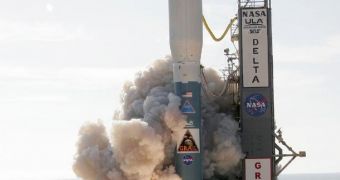The twin spacecraft making up the GRAIL mission successfully lifted off to space on Saturday, at 9:08 am EDT (1308 GMT), after a couple of days of delays caused by bad weather and a possible glitch affecting the carrier rocket.
After all issues were taken care of, NASA officials were able to take advantage of a 1-second launch opportunity early Saturday morning, allowing the Delta II 7920H-10 delivery system to blast off from the Cape Canaveral Air Force Station's (CCAFS) Space Launch Complex 17B (SLC-17B).
The science mission is scheduled to begin as early as March 2012, depending on the success of the testing and commissioning phases. The twin probes will arrive at Earth's natural satellite in three-and-a-half months, around New Year's Eve.
The two will not be arriving at the same time. Though they are placed on the same orbit – which will take them through the Sun-Earth Lagrange Point 1 – GRAIL-A will be arriving on New Year's Eve, whereas its sister spacecraft will arrive on January 1, 2012.
As soon as its primary mission starts, scientists will be able to answer fundamental questions about the Moon’s composition, internal structure and evolution. Our planet's evolution, and the early history of the solar system implicitly, will also become clearer.
One of the most interesting aspects of the new mission is that its results will be combined with the detailed topographical models of the Moon's surface that were produced by the NASA Lunar Reconnaissance Orbiter (LRO).
The purpose of the mission is to fly the two spacecraft in formation through multiple lunar orbits. As this happens, various areas will pull on the probes with varied strengths. By constantly measuring the distance between them, the instruments will be able to map the lunar interior.
The distribution of matter within the body itself is of special interest to experts, who say that this will give them fresh new insight into how the Moon came to its current appearance. “Our GRAIL twins have Earth in their rearview mirrors and the moon in their sights,” David Lehman explains.
“The mission team is ready to test, analyze and fine-tune our spacecraft over the next three-and-a-half months on our journey to lunar orbit,” adds the expert, who is the GRAIL project manager at the NASA Jet Propulsion Laboratory (JPL) in Pasadena, California.
“If there was ever any doubt that Florida's Space Coast would continue to be open for business, that thought was drowned out by the roar of today's GRAIL launch,” NASA Administrator Charles Bolden said following Saturday's launch.
“GRAIL and many other exciting upcoming missions make clear that NASA is taking its next big leap into deep space exploration, and the space industry continues to provide the jobs and workers needed to support this critical effort,” the official concluded.

 14 DAY TRIAL //
14 DAY TRIAL //